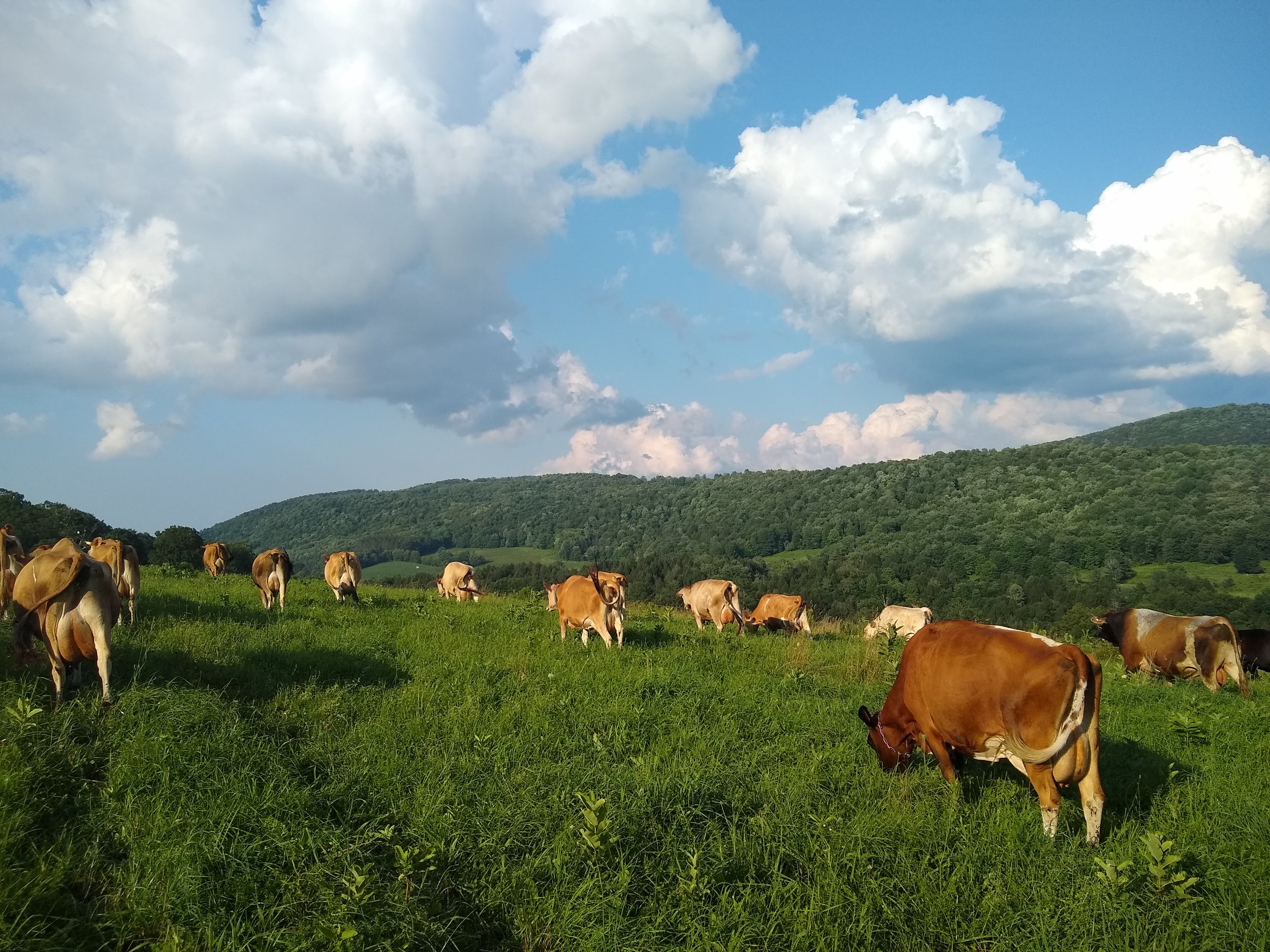
OUR METHODS
Table of contents:
Click on one to learn more!
At Family Farmstead Dairy we believe that everything should be kept as natural as possible. This idea is the main factor behind everything we do, how we raise and care for our animals, the products we produce, and what goes into each. The outcomes are USDA Certified Organic, Regenerative and hopeful in revitalizing Central New York small family farms.
ORGANIC
What does it mean to be a USDA certified organic dairy?
of course most things in this natural world are technically “organic”, but in the food industry the certification offers a level of transparency between the consumer and producer. IT is a good way for the consumer to reconnect to their food supply even if they are living far from its source.
On the farm level the certification deals with 3 main things
DIET
Cows must receive approved feed which is non-GMO, and grown without the use of synthetic pesticides or fertilizers. Cows must have access to pasture a minimum of 120 days / year, and 30% of their diet should consist of pasture grass during grazing season.
ANIMAL WELFARE
The cows must have freedom of movement and access to the outdoors and sunshine. The use of antibiotics, vaccines, growth hormones are prohibited. Holistic and preventative healthcare methods are practiced.
LAND
The farmland cannot be treated with synthetic pesticides or fertilizers. No GMO crops can be grown. To reduce cross contamination from neighboring farms, buffer zones are implemented. Adequate grazing space dependent on herd size is also considered.
On the Processing level the certification
deals with 2 main things
INGREDIENTS
All ingredients that are used can not be derived from genetic engineering or synthetic creation, they can not be exposed to pesticides, artificial fertilizer, sewage sludge or irradiation.
CLEANING CHEMICALS
All chemicals used in the facility must be reviewed and approved. the cleaning solution also has to be deemed safe.
Being Certified Organic is a wonderful way to improve clarity with the public on basic agricultural practices used.
We go above and beyond these requirements by our other methods used. Continue reading to learn more!
Regenerative Agriculture is a buzzword that has been going around lately. The regenerative certification allows us to clearly separate from farming practices that have essentially degenerated the area they were once part of.
“Regenerative agriculture focuses on restoring the health of the entire ecosystem. It promotes biodiversity, soil health, water conservation, and climate resilience.
Practices used in regenerative farming include minimizing soil disturbance, maintaining living roots, keeping armor on the soil, building biodiversity, and integrating livestock.
The goal is to produce nutritious and high-quality food while also contributing to the overall well-being of the environment, ecosystem, farmer, and our communities.”
Regenified.com
REGENERATIVE
Recent work across pasture land revealed root systems extending 32” below the surface!
By being Certified Regenerative we routinely show that our farming practices are improving the soil health and ecosystems on each of our contributing farms. As a collective group of farms, we are regenerating the land that has been bestowed to us for generations to come.
100% GRASS-FED
100% grass-fed means our cows eat all grass, all the time!
NO grain, which is the primary component of conventional dairy farms.
Historically cattle have flourished on grass pastures. The cows would retrieve most of the nutrients from the stem while the seed head would pass undigested through the intestines and land back on the soil surrounded by fertilizer (cow manure) ready to sprout. The cattle were living in a symbiotic relationship with the land.
Overtime cows have been taken off the land and put into barns where they are fed high energy feed to increase milk production. While this system increases efficiencies, we believe it decreases other things, such as milk quality and animal welfare.
Digestion
Cows’ stomachs are proven to be an ideal system to breakdown and convert diverse grass types into usable energy.
The bovine stomach has two main types of digesting microbes. grass digesting microbes and grain digesting microbes. Although grass and grain are technically part of the same plant, the tough fiber in the grain makes it more difficult to digest. If eating primarily a grain diet, the acidity in the cow’s stomach will drop to break down the tough fiber and collect nutrients. Due to the pH levels of the stomach, only one type of microbe can dominate the digestive process at once so unfortunately the grass portion of the plant (stem, stalk, leaf) will not be properly digested.
The low Ph of the stomach when digesting grain is harsh on the surrounding organs of cow. This is a main reason the average life span of a conventional dairy cow is only 4.5 - 6 years when their natural life span is closer to 20 years!
The grain-digesting microbes in a cow’s stomach are useful in the case of a drought or when pasture conditions are not ideal, and no lush plant life exists. By being able to switch over to grain-digestion, cows are able to survive many adverse conditions. They are most suited however to browse on natural forage.
With proper rotational grazing methods; diversity and health of plant life on pastureland can flourish. Different species with varying root depths emerge and help the cattle harvest more nutrients resulting in heathier milk. The grazing methods necessary for this diet result in greater biodiversity and stronger ecosystems.
A 100% grass fed diet is natural for the cow, resulting in animals that live longer, healthier lives.
Being 100% grass-fed also means that our milk is unique, changing taste as the cows’ diet changes. In the summer, they eat fresh grass. In the winter they may eat dry hay or baleage (fermented grass). This results in a wide variety of flavors in our milk. What doesn’t change, however, is how good it is for you. Milk from grass-fed cows offers many health benefits, including higher Omega-3’s, more CLA’s, digestible proteins, and heart-healthy fats.
FULL FAT
Contrary to what we have been told, Whole Milk containing an ample amount of fat is great for the body! Especially fat from grass fed cows!
Being home to fat soluble vitamins A, E, and K, containing a greater amount of Omega 3s and higher concentrations of CLA’s, the fat is truly the cream of the crop, providing heart healthy and cancer fighting properties!
Ever since the post WW2 era there has been a big push to incorporate butter/cheese byproducts into mainstream consumption. Often labelled as “health foods” due to their reduced fat content, these byproducts actually confuse the body. Leaving behind an unsatisfied appetite leading to an increased overall caloric intake.
This effect is often glorified for the fattening of pigs before slaughter. The profits associated with human food production compared to local animal feed operations, however, are too tempting for some dairy processors to refuse.
You’re not a Pig.
Choose Whole Milk or No Milk!
NON-HOMOGENIZED
Creamline
Created in 1899, Homogenization is the mechanical process of breaking apart and dispersing milk fat molecules to create a uniform consistency and color.
This process uses intense pressure to permanently alter the structure of fat particles. The protective membrane that surrounds the fat molecule is destroyed and the molecule is reduced in size. Casein proteins bind to the smaller unstable fat molecules creating a new, unnaturally shaped molecule. This drastically increases the rate of absorption.
The intestinal tract is designed to absorb nutrients in a proper order. Speeding up the absorption of fat molecules could pose several developmental issues.
Non-Homogenized milk means the structure of the milk is unchanged, in its natural state, easy for your body to recognize and properly digest it.
We will always keep the fat in its natural state, resulting in a more golden body and thick cream top layer across all our products.

LOW-TEMP PASTEURIZATION
Pasteurization is the process of heating milk up to kill any pathogenic microorganisms that may be present. There are different types of pasteurization that require varying temperatures over different time periods. Process methods have changed to improve efficiency by utilizing higher temperatures and less holding times, but these methods have resulted in a degradation of product quality. Fat soluble vitamins and protein chains are severely damaged in high temperatures; thus, their nutrient availability is lost. We will always pasteurize our products using the lowest temperatures and longer hold times to help preserve the quality of our products.
Low Temperature Pasteurization
Or
Vat / Batch Pasteurization
A slower and less severe heat treatment process for milk
While being substantially less efficient as a process method, Vat pasteurization preserves product quality better than all other methods.
Fat soluble vitamins (the most prominent in milk) and protein chains are seriously damaged in higher temperatures. Making their nutrient absorption difficult if not impossible.
To better understand this keep an eye out for the different milk pasteurization methods seen below:
Vat pasteurization ≥ 145F for 30 mins
High Temp Short Time (HTST) (HHST) ≥ 161 F for 15 seconds
Ultra High Temp (UHT) ≥ 280 F for ~2seconds
A-2 PROTEIN
100% A2 dairy is not widely available. Even directly sourcing your milk from a single farm does not guarantee that the proteins will be exclusively A2. Family farmstead milk is from a small group of exceptional farms. In most cases the cows are known by name, and we ensure that each one is tested and confirmed to produce only A2 proteins.
A1 VS A2
Several studies have been done around the world to determine the differences between A1 and A2 proteins. There are three main functions that these beta casein proteins affect:
Digestive:
Milk composed of only A2 proteins is easier to digest, with fewer uncomfortable side effects. It affects how you feel immediately after consuming A2 proteins. We urge you to try it for yourself as it’s been proven true by our family and friends.
Metabolic:
A2 proteins are linked to more positive health effects and fewer negative health effects for how your body uses it as compared to A1 proteins.
Cognitive:
Your brain functions differently when you consume A2 proteins. People who drink A2 proteins regularly have demonstrated the ability to solve problems quicker and more accurately than people who regularly drink A1 proteins.
A1 & A2 protein chains
Milk has several types of proteins, and one of those proteins is beta casein. There are two main variants of beta casein: A1 and A2. The variant is determined by the genetics of the cow. Originally there was one form of this chain in all dairy producing animals (Humans included!). This is known as the A2 protein chain.
A1 is the most common variant today and is found in virtually all milk on store shelves. This mutated protein chain has been shown to cause several digestive issues. The A2 protein chain is less common, and sources of milk containing only A2 proteins can be hard to find.



















